
After unveiling the Snapdragon 888 yesterday, Qualcomm detailed the Snapdragon 888, the company’s latest 5G Mobile Platform that is built on 5nm process technology from Samsung. The SoC uses Qualcomm Kryo 680 cores clocked up to 2.84GHz offering up to a 25% improved CPU performance, thanks to new Arm Cortex-X1 prime core. The Qualcomm Adreno 660 GPU offers up to 35% faster graphics rendering and is 20% more power efficient compared to the Snapdragon 865.
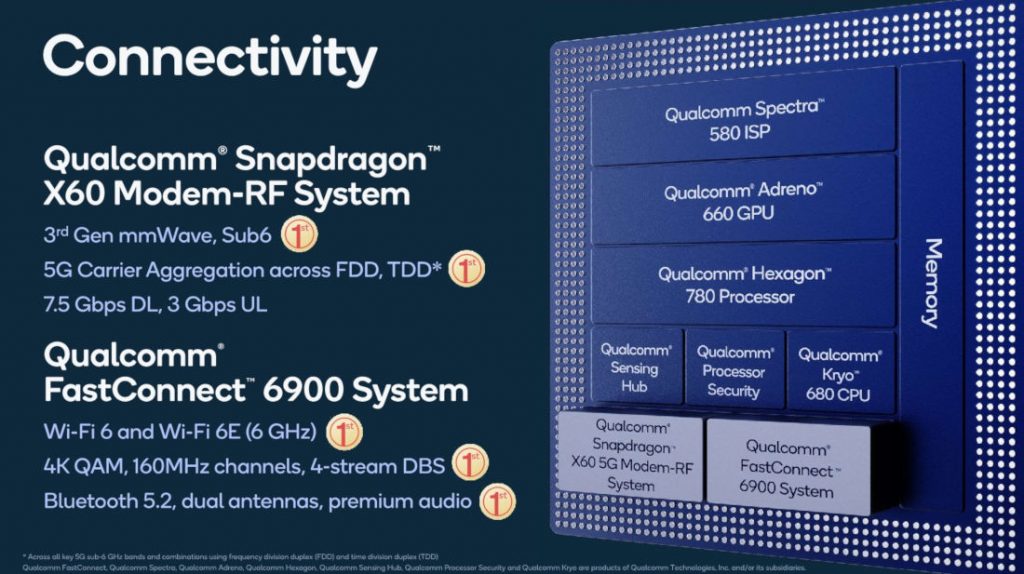
It has integrated 3rd generation Snapdragon X60 5G modem with 5G sub-6 carrier aggregation and mmWave support offering 5G speeds up to 7.5 Gbps. It features Qualcomm FastConnect 6900 Mobile Connectivity System with Wi-Fi 6 and also supports new 6 GHz capacity with Wi-Fi 6E, includes Bluetooth 5.2, dual Bluetooth antennas, Qualcomm aptX suite, broadcast audio and advanced modulation & coding optimizations. This has 6th generation Qualcomm AI Engine with the new Qualcomm Hexagon 780 processor offering 26 TOPS AI performance.
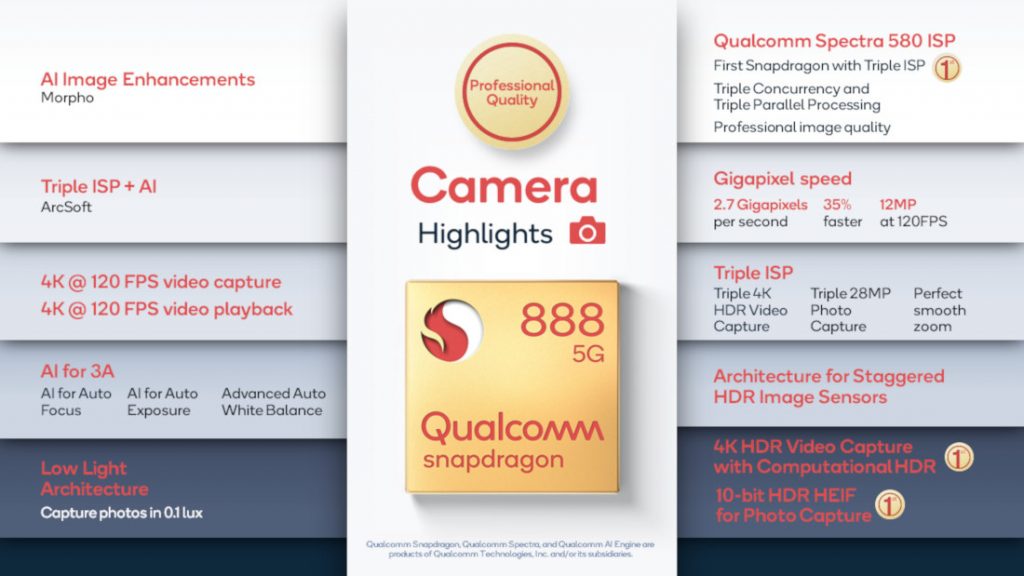
The new Qualcomm Spectra 580 ISP is the first Snapdragon with a Triple Image Signal Processor (ISP), capable of capturing from three cameras simultaneously at processing speeds—up to 2.7 gigapixels per second, 35% faster than the previous generation. This also debuts a new low light architecture, for brighter photos, even in near darkness.
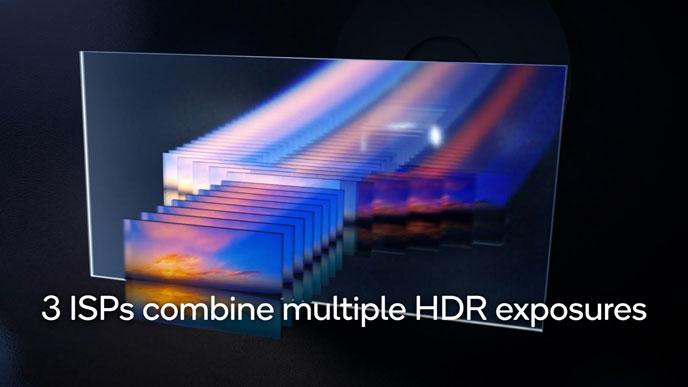
Qualcomm said that the Spectra 580’s architecture is designed for image sensors called staggered HDR. They will be debuting in smartphones soon and have the potential to dramatically enhance HDR video quality. Staggered HDR image sensors output separate long, medium, and short exposures, and with the Qualcomm Spectra 580’s triple concurrency can merge all of these images together to bring you one final image with incredible dynamic range. This technique has been available for photo capture. But for the first time on Snapdragon you will be able to capture 4K HDR with computational HDR.
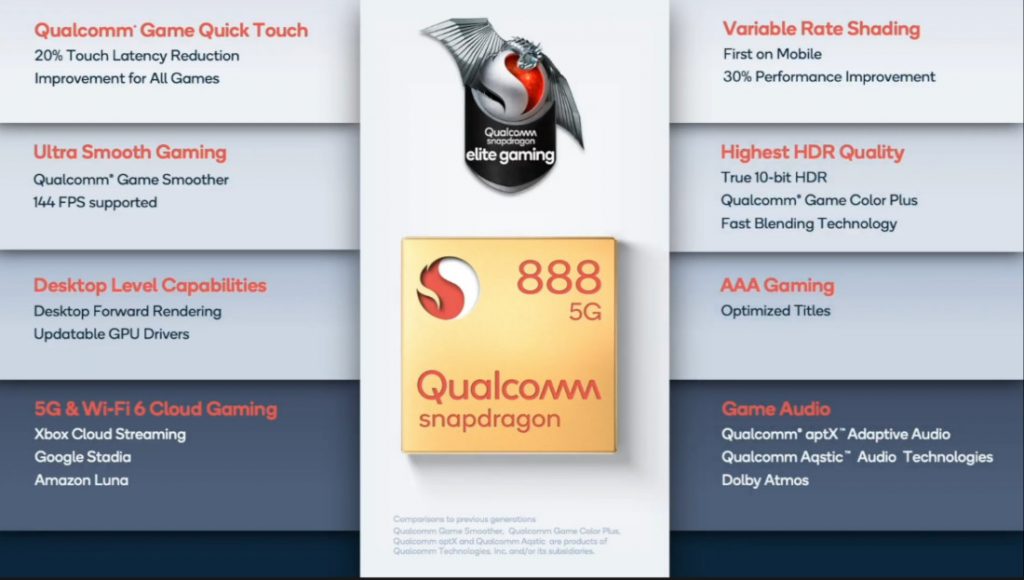
Snapdragon Elite Gaming brings Variable Rate Shading (VRS) to mobile devices for the first time, previously available only on PCs and next-gen consoles. Powered by the new Adreno 660 GPU, VRS helps reduce GPU workloads and provides significant enhancements to games making them run faster and at higher resolutions while still maintaining the highest visual fidelity. Games will see a 30% increase in gameplay performance from previous Snapdragon chipsets while running smoother and longer with lower power, says Qualcomm.
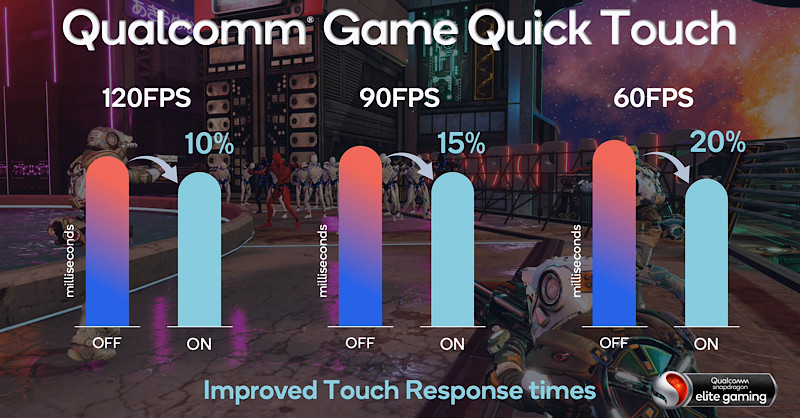
The new Qualcomm Game Quick Touch feature in Snapdragon 888 greatly reduces touch latency by up to 20%, and is automatically applied even when you play games at 120 fps.

The 6th gen Qualcomm AI Engine Hexagon 780 processor has been completely redesigned and features its biggest leap in architecture and performance in years. This combines scalar, vector, and tensor accelerators, so it’s now on one big AI accelerator. There is a dedicated large shared memory across the three different accelerators, so they can share and move data efficiently. The shared memory is 16x larger than its predecessor, and the result is an impressive hand-off time between the accelerators in the nanosecond range — up to 1000x faster in certain use cases. The scalar accelerator is 50% more powerful; the tensor accelerator is now two times faster than in the Snapdragon 865, and the Qualcomm Hexagon Vector eXtensions (HVX) now supports additional data types.
Adreno 660 GPU now offers a 43% AI performance boost and includes new instruction sets like 4-input mixed precision dot product and wave matrix multiply for faster floating-point calculation. It offers 26 TOPS performance, the highest on mobile.
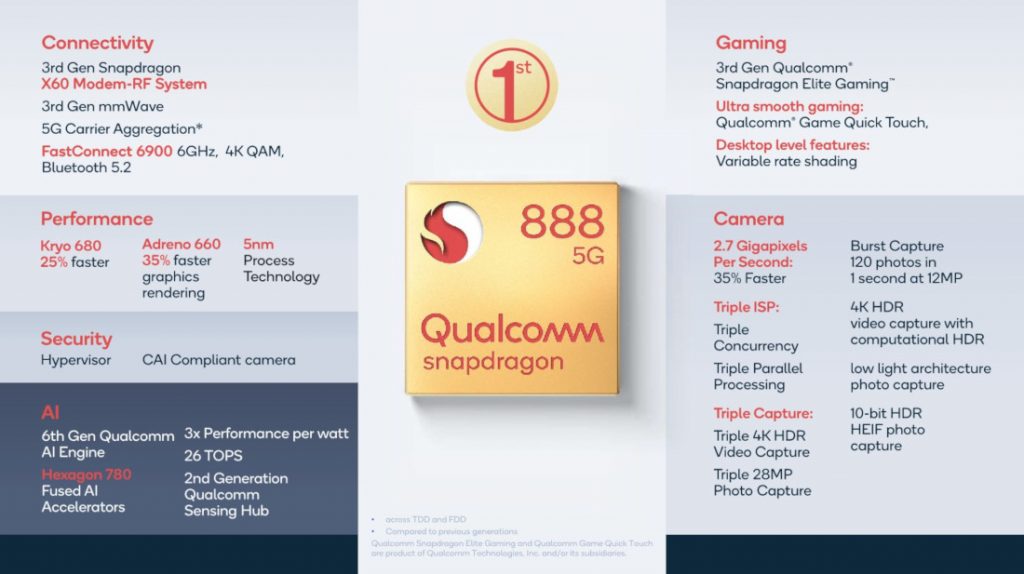
Highlights of Qualcomm Snapdragon 888
- 1 x Kryo 680 Prime CPU (Arm Cortex-X1-based) at up to 2.84GHz, 3 x Kryo 680 Performance CPUs (A78-based) at up to 2.42GHz, 4x Kryo 680 Efficiency CPUs (A55-based) at up to 1.80GHz
- Samsung 5nm (5LPE) Process Technology
- Built-in Qualcomm Snapdragon X60 5G modem-RF system
- 5G speeds of up to 7.5Gpbs down and 3 Gbps up, 5G mmWave: 800 MHz bandwidth, 8 carriers, 2×2 MIMO, 5G sub-6 GHz specs: 200 MHz bandwidth, 4×4 MIMO
- Qualcomm Adreno 660 GPU , OpenCL 2.0 FP, OpenGL ES 3.2, Vulkan 1.1, DX12, Volumetric VR video playback, 8K 360 VR video playback
- Dolby Vision, H.265 (HEVC), HDR10+, HLG, HDR10, H.264 (AVC), VP8, VP9
- Qualcomm Aqstic smart speaker amplifier up to Qualcomm WSA8835, Qualcomm Hexagon Voice Assistant Accelerator, Qualcomm Aqsti™ audio codec up to Qualcomm WCD9385, Qualcomm Aqstic audio technology
- Up to 28 MP triple camera, Up to 64MP dual camera, Up to 84 MP single camera with ZSL, Up to 200MP single camera, Qualcomm Spectra 580 Image Sensor Processor (14-bit triple-ISP), Real-time object classification, Low light photography architecture, 10-bit HDR HEIF photo capture, Multi-frame Noise Reduction (MFNR), 4K video capture with simultaneous 64MP photo capture, Rec. 2020 color gamut video capture, Up to 10-bit color depth video capture, 4K Video Capture at 120 FPS, Slow-mo video capture at 720p at 960 FPS, HEVC Video Capture, HDR10+, HDR10, HLG support, 4K HDR Video Capture with Portrait Mode (Bokeh)
- On-Device Display Support: 4K at 60 Hz / QHD+ at 144 Hz, Maximum External Display Support: up to 4K @ 60 Hz, 10-bit color depth, Rec. 2020 color gamut, HDR10 and HDR10+
- Qualcomm Hexagon Vector eXtensions (HVX) for AI and imaging, Qualcomm Hexagon Vector Accelerator, Qualcomm Hexagon Tensor Accelerator, Qualcomm Hexagon Voice Assistant, Qualcomm All-Ways Aware technology, 26TOPS AI performance
- LPDDR5 3200MHz, 4x16bit memory / 44.0GB/s or LPDDR4X 2133MHz / 33.4GB/s
- Wi-Fi 6E, 802.11ax (Wi-Fi 6) Multi-gigabit, Integrated 802.11ac 2×2 (2-stream) MU-MIMO, 2.4 GHz, 5 GHz and 60 GHz, Bluetooth 5.2, NFC
- Beidou, Galileo, GLONASS, Dual frequency GNSS, GNSS, GPS, QZSS, NavIC,SBAS
- USB 3.1, USB-C
- Qualcomm Quick Charge 5 technology
Qualcomm Snapdragon 888-powered devices are expected in the first quarter of 2021. Several companies had already confirmed their plans to introduce new phones with Snapdragon 888 in coming months.
